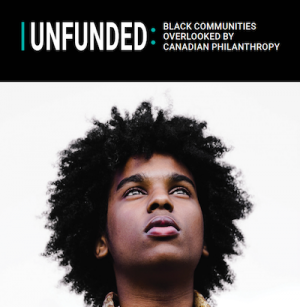 Until 2022, Shawn Bunsee was Vice President of Data & Analytics and Chief Privacy Officer at CanadaHelps, a registered charity that increases charitable giving by working with donors and nonprofit organizations. Before working in the nonprofit sector, Bunsee had a background in the for-profit, technology sector, and often felt like an outsider looking into the nonprofit sector, a perspective that brought fresh analysis to his nonprofit work. While at CanadaHelps, he built a team of data analysts, researchers and analytics engineers, and created structures and processes for data, business intelligence and analytics. He’s now the Manager of Analytics at Wavelo, a software company. In this third article of our Data series, he spoke to PANL Perspectives about his outsider’s perspective on data issues in the nonprofit sector. The interview has been shortened and edited in parts.
Until 2022, Shawn Bunsee was Vice President of Data & Analytics and Chief Privacy Officer at CanadaHelps, a registered charity that increases charitable giving by working with donors and nonprofit organizations. Before working in the nonprofit sector, Bunsee had a background in the for-profit, technology sector, and often felt like an outsider looking into the nonprofit sector, a perspective that brought fresh analysis to his nonprofit work. While at CanadaHelps, he built a team of data analysts, researchers and analytics engineers, and created structures and processes for data, business intelligence and analytics. He’s now the Manager of Analytics at Wavelo, a software company. In this third article of our Data series, he spoke to PANL Perspectives about his outsider’s perspective on data issues in the nonprofit sector. The interview has been shortened and edited in parts.
Question: What tips do you have about obtaining data about the nonprofit sector?
 Bunsee: Some of the government sources are pretty good if you’re looking for donations data — T3010 data and tax-filer data from the Canada Revenue Agency (CRA), for example, can be combined with census or other data from Statistics Canada and data from Canada Post. And if you want to take it further, combine those with expensive data purchased from commercial sources, such as Environics. Some of the challenges of obtaining data, though, are that it’s not always free, and, to be honest, people in the nonprofit sector like “free.”
Bunsee: Some of the government sources are pretty good if you’re looking for donations data — T3010 data and tax-filer data from the Canada Revenue Agency (CRA), for example, can be combined with census or other data from Statistics Canada and data from Canada Post. And if you want to take it further, combine those with expensive data purchased from commercial sources, such as Environics. Some of the challenges of obtaining data, though, are that it’s not always free, and, to be honest, people in the nonprofit sector like “free.”
But even when it’s free, it’s not straightforward to get a hold of. T3010 data, for instance, is publicly available and is free, but you need to know that you have to request the data from the Charities Directorate, at the CRA — and the big thing for me was that, in 2022, when I last worked at the data, it comes as a CD of csv files. I mean, are there even any computers made that contain CD drives? So, you have to figure out how to obtain the data from this archaic method of delivery.
Also, we can continue asking the government to provide us with more and better data, but frankly, that hasn’t been happening over the past years. CRA, to take one example, is busy with tax-filer data, and charitable-giving data is only a tiny part of that. The nonprofit sector has to grow up and take data seriously; it has to collect and generate its own real data, instead of looking to others. The one thing I find in the nonprofit sector that’s not common in the for-profit sector, is that nonprofit organizations collaborate — and a wealth of real data could be generated and shared through nonprofit collaboration.
Q: Are there challenges with analyzing the data that’s currently available about our sector?

In another article in this Data series, the President & CEO of Philanthropic Foundations Canada spoke to us about what can be done to improve data from the T3010 and other sources.
Bunsee: There are challenges about the quality and freshness of the data. Generally, in my opinion, the data from government sources is good, from a data-validation perspective — there’s not an exorbitant amount of data cleaning to be done — but the actual information inputted by tax filers isn’t great. Charities aren’t good at completing the T3010 for example. You’re going to have data-quality challenges when charities aren’t taking the care to answer the questions properly; there’s the principal “Garbage In, Garbage Out,” and that’s a data-quality concern to consider before starting to analyze T3010 data sets.
With tax-filer data, quality is more around understanding the purpose of why the data was collected: data is collected from individuals filing their taxes. To optimize tax credits, the highest earner in a family claims all of the donations, for instance. Unfortunately the pay gap still exists, and often these higher earners are males (in male-female couples), resulting in bias. The female partner may be doing the donating, but the male, the higher earner, claims the tax credit to optimize family donations. That’s a challenge in terms of data quality — and there are other examples of this — and all those are legal!
Then there are the illegal things, like people using donations as loopholes to cheat on their taxes, which was something I was naïve about when I first started. Some researchers have done years of work to account for this kind of cheating when they’re analyzing tax-filer data, but where do you turn if you don’t have access to those analysts?
Q: What about the data created by the nonprofit sector itself? Is much of it reliable?
 Bunsee: There are forward-thinking organizations, within the sector, that create their own data — research, analysis, thought-leadership — and that’s a good thing. But I’d say to use that data cautiously and objectively, and to know that, even with positive intent, there are going to be biases when organizations have narratives they want to push or control. An example is an organization that’s looking for funding for a particular charitable service and, as its narrative, claims that demand for that service is up and donations for that service are down. In short, there may be pressure to suppress data or fudge numbers to create a narrative the organization wants. So, you need to be careful when using data that may have been manipulated or not validated.
Bunsee: There are forward-thinking organizations, within the sector, that create their own data — research, analysis, thought-leadership — and that’s a good thing. But I’d say to use that data cautiously and objectively, and to know that, even with positive intent, there are going to be biases when organizations have narratives they want to push or control. An example is an organization that’s looking for funding for a particular charitable service and, as its narrative, claims that demand for that service is up and donations for that service are down. In short, there may be pressure to suppress data or fudge numbers to create a narrative the organization wants. So, you need to be careful when using data that may have been manipulated or not validated.
In analytics about the charitable sector, the truth is more beneficial than narratives, because, with truth, you can uncover challenges and opportunities to fix them. Or you can discover wins, and build on those wins. You have to be careful with data. In general, when analyzing data, you need to be objective — look at other data sources to help validate a conclusion that you received from a third-party source, or challenge analyses that can’t be validated. These are best practises of data analysis.
Q: Is there a culture of data-driven decision-making in our sector?
Bunsee: As an outsider, and this perspective might be controversial, but I think, in my opinion, there’s one big thing that could be done to make data better — and it has nothing to do with government and nothing to do with collaboration or anything like that (which I think can help, and I saw efforts to do that when I was in the sector). But one thing for me is: charities just need to grow up when it comes to data. It’s a really harsh statement, but I think it’s true. Many charities believe that they should spend their efforts only on mission and believe that everything else is noise. They don’t realize that investing in modernizing their systems, including how they deal with data, would help their mission now and in the future.
Q: What do you mean “charities need to grow up”?
 Bunsee: There are three things that charities need to do. First, invest in technology. In 2023, the practice of saving data in Excel files or keeping paper files is wild. You need to invest in how you treat data the same way you treat any other form of currency — the same care, the same security. Real data, about real people, is valuable to your work, and it affects people’s lives.
Bunsee: There are three things that charities need to do. First, invest in technology. In 2023, the practice of saving data in Excel files or keeping paper files is wild. You need to invest in how you treat data the same way you treat any other form of currency — the same care, the same security. Real data, about real people, is valuable to your work, and it affects people’s lives.
Number two, don’t nickel and dime your people, not just the people doing data collection and analysis, but all your staff and volunteers. For lack of a better word, I think that the charitable sector is exploitative when it comes to paying people. I joke about how charities like services for free, but they also want labour for free. Sometimes, volunteers are expected to do things that, really, they should be paid for. These aren’t signs of modern, healthy organizations.
And, as a person of colour, it’s not lost on me that often, the data analytics folks who are underpaid, and not only in the charitable sector, are from BIPOC communities and are new Canadians. There’s an exploitative mindset.
Third, look at the for-profit world for models of innovation. For much of my time in the nonprofit sector, there was a loathing and mistrust of the for-profit sector, with only one exception, when corporations opened their coffers to give. But as soon as that cheque cleared, it was back to hating the for-profit sector. You can continue to loath the greedy corporations that might be raising prices beyond inflation and so on, but at the same time, you can look to the for-profit world for innovation and realize that you’re competing with them in terms of corporate investment, talented staff, and, increasingly, in terms of delivery of services. You can’t be stuck in the 1990s when we’re in 2023.
Q: Can you be more specific about innovation in terms of data and technology?

In a second article in our Data series, Michael Lenczner, the founder and CEO of Ajah, talks about issues and challenges related to data technology and training in the nonprofit sector in Canada.
Bunsee: Many charities are still struggling with on-premises databases or servers at a data centre. There’s no question that organizations and companies need to invest in things like cloud warehousing, or data security, or business analytics, or data science — and I could go on. For the most part, the for-profit world has already executed on these things, as they’re needed to be successful. Most have moved past this, and are now focusing on AI, especially machine learning that takes human biases out of basic decision-making, such as who gets what services, or where resources should be allocated.
Organizations — for-profit and nonprofit — should be making decisions, such as fundraising decisions, using data analysis as inputs. I don’t think this is happening widely in the nonprofit sector. Often, decisions are made from gut feeling, or are made by one person or a committee of people, based on their experiences and ideas. When it comes to machine learning, much of that goes away. That’s going to be controversial, because the people who decide using their gut feelings, want to continue deciding using their gut feelings. And I know that AI can be problematic, but for basic things that it’s good at, AI allows us to use real data and fewer biases. But, as I said, nonprofit groups don’t have to look into AI; they can start with looking at real data, and believing the data.
Q: Can you explain how issues about real data and biases apply to fundraising?

In 2020, a new report, “Unfunded: Black Communities Overlooked by Canadian Philanthropy,” provided the first in-depth examination of the relationship between Canadian philanthropy and Black communities.
Bunsee: I indirectly worked in the fundraising space in the nonprofit sector. My understanding of fundraising is that it’s very much about building relationships with people, but you often build the relationships with communities you’ve always built relationships with, and maybe you’re ignoring marginalized communities that want to give, that may not have as much to give but that have higher numbers of people who want to give. So, if you’re making decisions based on your own lived experience, then you’re probably missing out on stuff, compared to using data and a properly built model that may uncover a whole new set of communities and potential fundraisers.
Another example: you hear about how Millennials or Gen Zers don’t donate, so we should focus on the Boomers, who historically have given more, but Millennials give. They give to causes and movements, such as Black Lives Matter, but not necessarily to charities. You shouldn’t be myopic just because they don’t give to charities. You need to look at the data points to find out why.
Shawn Bunsee is on LinkedIn.
Photos in the banner and elsewhere are courtesy of Florian Hahn, Grégoire Bertaud and Gary Bendig.
Tuesday, June 27, 2023 in Data Discoveries, For homepage, News & Events
Share: Twitter, Facebook



